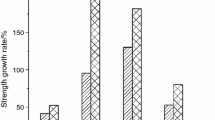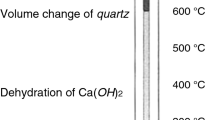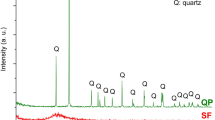Abstract
The use of active mineral additions is an important alternative in concrete design. Such use is not always appropriate, however, because the heat released during hydration reactions may on occasion affect the quality of the resulting concrete and, ultimately, structural durability. The effect of adding up to 20% silica fume on two ordinary Portland cements with very different mineralogical compositions is analyzed in the present paper. Excess gypsum was added in amounts such that its percentage by mass of SO3 came to 7.0%.
The chief techniques used in this study were heat conduction calorimetry and the Frattini test, supplemented with the determination of setting times and X-ray diffraction. The results obtained showed that replacing up to 20% of Portland cement with silica fume affected the rheology of the cement paste, measured in terms of water demand for normal consistency and setting times; the magnitude and direction of these effects depended on the mineralogical composition of the clinker. Hydration reactions were also observed be stimulated by silica fume, both directly and indirectly – the latter as a result of the early and very substantial pozzolanic activity of the addition and the former because of its morphology (tiny spheres) and large BET specific surface. This translated into such a significant rise in the amounts of total heat of hydration released per gram of Portland cement at early ages, that silica fume may be regarded in some cases to cause a synergistic calorific effect with the concomitant risk of hairline cracking. The addition of excess gypsum, in turn, while prompting and attenuation of the calorimetric pattern of the resulting pastes in all cases, caused the Portland cement to generate greater heat of hydration per gram, particularly in the case of Portland cement with a high C3A content.
Similar content being viewed by others
References
S Mindess J Young et al. (1981) ‘Concrete’ Prentice-Hall, Inc. Englewood Cliffs, New Yersey
H. Ushiyama, Y. Shigetomi and Y. Inoue, ‘Effect of gypsum on the hydration of alite and belite’, Proceedings of 10th International Congress on Chemistry of Cement, Vol. II, Göteborg, Norway 1997, p. 4.
AA Amer (1998) J. Thermal Anal. 54 837 Occurrence Handle10.1023/A:1010100222075 Occurrence Handle1:CAS:528:DyaK1MXhtVSksL0%3D
Z Giergiczny (2004) J. Therm. Anal. Cal. 76 747 Occurrence Handle10.1023/B:JTAN.0000032259.80031.b2 Occurrence Handle1:CAS:528:DC%2BD2cXkvFGgtb0%3D
E El-Shimy SA Abo-El-Enein H El-Didamony TA Osman (2000) J. Therm. Anal. Cal. 60 549 Occurrence Handle10.1023/A:1010194921099 Occurrence Handle1:CAS:528:DC%2BD3cXkvF2qsbk%3D
A. Durehovi, ‘Hydration of alite and C3A and changes of some structural characteristics of cement pastes by addition of silica fume’, Proceedings of 8th International Congress on Chemistry of Cement, Vol. III, Brasil 1986, pp. 279–285.
K. Asaga, H. Kuga, S. Takahashi, E. Sakai and M. Daimon, ‘Effect of pozzolanic additives in the Portland cement on the hydration rate of alite’, Proceedings of 10th International Congress on Chemistry of Cement, Vol. III, Göteborg, Norway 1997, p. 8.
A Sharara H El-Didamony E Ebied A El-Aleem (1994) Cem. Concr. Res. 24 966 Occurrence Handle10.1016/0008-8846(94)90017-5 Occurrence Handle1:CAS:528:DyaK2cXkvFSjsbc%3D
M. Maage, ‘Strength and heat development in concrete: Influence of fly ash and condensed silica fume’, Fly Ash, Silica Fume, Slag and Natural Pozzolans in Concrete, ACI SP 91-44, 1986, pp. 923–940.
R Pinto K Hover (1999) ACI Mater. J. 96 600 Occurrence Handle1:CAS:528:DyaK1MXnvFahurw%3D
D. Roy, ‘Fly ash and silica fume chemistry and hydration’, Fly Ash, Silica Fume, Slag and Natural Pozzolans in Concrete, ACI SP 114-5, 1989, pp. 117–138.
V. Rahhal, ‘Characterization of pozzolanic additions by conduction calorimetry’, Ph.D. Tesis, ETS Ings. CCP, Polytechnic University of Madrid-Spain, 12 Dec. 2002.
J Larbi A Fraay M Bijen (1990) Cem. Concr. Res. 20 506 Occurrence Handle10.1016/0008-8846(90)90095-F Occurrence Handle1:CAS:528:DyaK3cXltlOmsrg%3D
R. Talero, ‘Contribution to the Analytical and Physico-Chemical Study of the System: Pozzolanic Cements-Gypsum-Water (at 20±3°C)’, Ph.D. Thesis, Ftad. de CC. Químicas, Univ. Complutense de Madrid, 20 Nov. 1986.
R. Talero, Patología y Terapias Preventivas del Hormigón II, La Capacidad de Cambio de las Adiciones Puzolánicas, Monografía no 406 del Instituto de C.C. Eduardo Torroja-CSIC, Madrid, Spain 1991.
R Talero (2004) Mater. Construc. 54 17 Occurrence Handle10.3989/mc.2004.v54.i276.253 Occurrence Handle1:CAS:528:DC%2BD2MXjvFamuw%3D%3D
R Talero (2005) Mater. Construc. 55 82
V. Rahhal, O. Cabrera and R. Talero, ‘Synergistic Calorific Effect of the pozzolanic reaction’, XXV Congreso Argentino de Química. Vol. 5-062, 2004.
R. Lannegrand: Private communication.
UNE 80-225-93 Standard: ‘Test methods for cements. Chemical Analysis: Reactive silica (SiO2 r–) content in cements, pozzolans and fly ashes’, AENOR, Calle Génova no 6, 28004 Madrid, Spain 1993.
R Talero (1990) J. Mater. Civil Eng. 2 106 Occurrence Handle10.1061/(ASCE)0899-1561(1990)2:2(106)
European Standard EN 196-3, ‘Methods of testing cement, Part 3: Determination of setting time and soundness’, AENOR, calle Génova no 6, 28004 Madrid, Spain 1987.
European Standard EN 196-5, ‘Methods of testing cement, Part 5: Ensayo de puzolanicidad para cementos puzolánicos’, AENOR, 1987, This Standard is similar to the Pliego de Prescripciones Técnicas Generales para la Recepción de Cementos RC-75 (BOE No. 206 de 28 de Agosto de 1975) N. Frattini: Ann. Chim. Appl., 39 (1949) 616.
H. Uchikawa and S. Uchida, ‘Influence of pozzolan on the hydration of C3A’, 7th International Congress on Chemistry of Cement, Vol. III, Paris 1980, pp. IV-24-IV-35.
Instrucción para la Recepción de Cementos RC-03 (Real Decreto 1796/2003, de 26 de diciembre).
Author information
Authors and Affiliations
Corresponding author
Rights and permissions
About this article
Cite this article
Rahhal, V., Cabrera, O., Talero, R. et al. Calorimetry of portland cement with silica fume and gypsum additions. J Therm Anal Calorim 87, 331–337 (2007). https://doi.org/10.1007/s10973-005-7324-1
Received:
Accepted:
Published:
Issue Date:
DOI: https://doi.org/10.1007/s10973-005-7324-1




